Worst Case Scenario is a flawed episode of Star Trek: Voyager. It is also breathtakingly ambitious.
There is a strong argument to be made that Worst Case Scenario is the strongest Star Trek script ever written by Kenneth Biller. It is a story about storytelling, using the holodeck as a jumping off point for all sorts of self-reflective commentary on the sort of creative compromises necessary to get an episode of television (and in particular an episode of Voyager) on the air. It also benefits from a cracking starting premise, a wonderful opening act, and some playful direction from Alexander Singer. All of these elements help to distract from obvious weaknesses.

Rebel, rebel.
Worst Case Scenario has a number of serious flaws. It makes very little sense from a logical perspective, with the script guilty of many of the criticisms that Tuvok makes of Paris’ approach to the craft of writing. The ending is rushed. The episode owes a sizable debt to Our Man Bashir, a much stronger episode of Star Trek: Deep Space Nine that used the holodeck to make similar (and more convincing) arguments about the nature of storytelling. Like many good-but-not-great Voyager episodes, Worst Case Scenario refuses to follow its ideas to their conclusions.
And yet, in spite of all of these issues, Worst Case Scenario is an endearing and playful piece of television. It is far too chaotic and unfocused to rank with the best of the franchise, but it is distinctive enough to stick in the memory without ever being embarrassing.
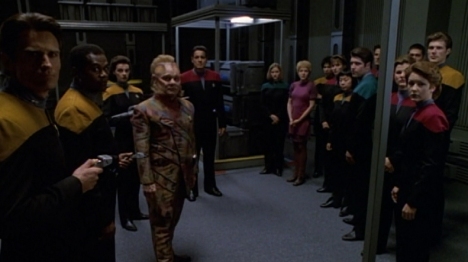
It’s all up to you.
The storytelling logic in Worst Case Scenario is loose, even by the standards that Voyager applies to concepts like characterisation or motivation. This is most obvious in the second half, when Worst Case Scenario is obligated to generate some stakes by turning the mutiny holonovel at the centre of the episode into a death trap that has been hijacked by holo!Seska. Of course, Seska is the most logical choice for that plot function; Lon Suder was not so sadistic in his violence, while Jonas was hardly the most convincing antagonist. However, it still makes no sense.
To be fair, Voyager was never a show particularly invested in characterisation. Seska is a prime example of this. In the first season, Seska had a reasonably consistent sense of motivation. In episodes like Prime Factors and State of Flux, Seska was defined as a character willing to do whatever it took to get home quickly. However, later episodes quickly lost any sense of direction for the character. She proved happy to remain with the Kazon Nistrim, while becoming monomaniacally fixated upon becoming Chakotay’s baby mama in Manoeuvres.

Well, hey. At least Seska’s hugely improbable attraction to Chakotay remains consistent.
Even looking beyond Seska, Voyager arguably has the most hazily-defined ensemble of the three twenty-fourth century Star Trek shows. Janeway’s personality is notorious fickle, prone to pivot on the whim of a plot. Tuvok is a stock Vulcan. Harry Kim never evolves past the factory settings of “young”, “inexperienced” and “insecure.” The decision in the third season to tone down the more stereotypical New Age Native American characterisation of Chakotay was a good decision. However, the writing staff never bothered to develop anything in its stead.
In fact, the militant and mutinous holo!Chakotay presented in Worst Case Scenario does not seem like a jarring contrast to the regular version of the character. Three seasons into the show, almost half-way to the end, Chakotay is still so hazily defined that it is entirely possible that he might be motivated by the logic that the ends could justify the means. Tellingly, the real Chakotay objects more vocally to his plot function than to his characterisation. “I don’t care what kind of story it is, as long as I’m not the bad guy this time,” he reflects on the possibility of a follow-up.

Well, to be fair, holo!Chakotay is a lot more exciting.
Even allowing for all of this, the characterisation of Seska in Worst Case Scenario makes no sense. Once the holonovel begins spiralling out of control, Torres discovers that Seska made the changes “about a month before she left the ship.” To be clear, these are changes that are designed to murder the Chief of Security in the most ridiculously showy manner possible. As soon as Tuvok trips that particular trap, everybody on the ship knows what is happening. The bridge lights up, and the crew are locked out.
Seska did not plan to abandon Voyager in State of Flux. In fact, her original plan seemed to be to remain on the ship while passing technology to the Kazon in return for support. Seska only defected to the Kazon when her treachery was discovered. With all of that in mind, why would Seska do something like this? Murdering Tuvok would most likely lead to her exposure, particularly given the way that holo!Seska brags so brazenly and ridiculously about it. It is fun to imagine what might have happened had Tuvok walked into the trap while Seska was still on board.

She certainly knows how to make an entrance.
After all, there is some suggestion that Seska was willing to do serious damage to the ship as part of her revenge upon Tuvok. She rigs the holographic ship to self-destruct, which in turn sets the holodeck to explode. “I don’t know how she rigged it, Captain,” Torres reports, “but when she ordered the self-destruct it initiated an overload in the holodeck power relays. The whole grid is going to blow.” What the hell is the point of all of this? Why would Seska do such a thing?
According to Worst Case Scenario, Seska is motivated by the treatment of the Maquis in the holonovel, feeling betrayed by Tuvok’s suggestion that they are inherently untrustworthy or mutinous. It is an understandable sentiment. Tuvok even alludes to it in the briefing, warning his fellow officers, “The programme has the potential to incite animosity among the crew and must be permanently deleted.” It is surprising that Chakotay is so relaxed about his portrayal in the programme, given that Tuvok betrayed him to the Federation.

Maq-ing the Maquis.
Seska makes this argument when she confronts Paris and Tuvok. “I would have thought all that time you spent spying on us might have given you a little more insight into the Maquis,” she teases, “but after looking over what you’ve already written, I can see you need a little help.” It is not the most elegant motivation, but it works reasonably well in isolation. Except, of course, that Seska was never a true believer in the Maquis. Seska was a Cardassian spy sent to infiltrate Chakotay’s cell, to betray him to her government.
Worst Case Scenario draws Seska in the broadest possible terms. In fact, she seems to be the antagonist of the episode because she is the closest thing that Voyager has to an iconic antagonistic figure. It does not matter that her motivations do not really fit the needs or demands of the plot. Seska can be shoehorned into the role of baddie because she fits that archetypal template. Seska was never a particularly nuanced or complicated character, but Worst Case Scenario is invested in the most two-dimensional version imaginable.
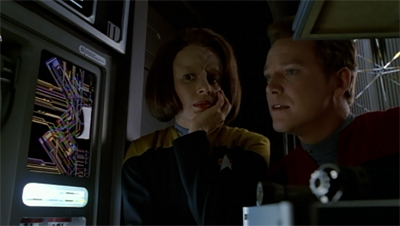
“Well, the image buffering is working, but the personality still can’t be rendered in three dimensions.”
Indeed, there’s a sense that the episode just really needs the audience to go along with it. Martha Hackett embraced the ridiculousness of her resurrection:
“I thought it was great that she thought ahead and planned something that would mess with people even after she wasn’t around,” Hackett said of the episode “Worst Case Scenario,” which resurrected her character in her original Bajoran guise. “There could have been more of that all along, every time there was a problem on the ship – ‘Oh, there she goes again!'”
Seska is very much a round peg being forced into a square hole. Her motivations are inessential. Worst Case Scenario needs an antagonist. Seska is an antagonist. So, she fills the role. It does not matter how awkwardly.
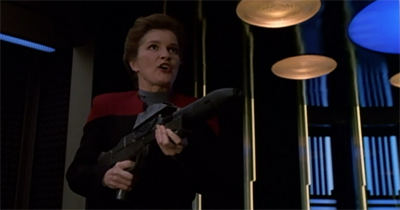
Janeway or the highway.
Then again, it feels very much like this might be the point of the exercise. About midway though Worst Case Scenario, Tuvok and Paris have a conversation about story construction. Discussing his plans for the next story beat, Paris suggests, “Well, I was thinking, Paris and Janeway retake the ship, and then she decides to execute all the conspirators.” Tuvok balks at the idea. “That is an entirely implausible plot development. Captain Janeway would never behave in such an inhumane manner.” It is a statement that seems hilarious after Equinox, Part II.
Still, assuming that this observation is true of Janeway’s character at this moment, Paris does not buy that as a reason not to tell the story. “This isn’t real life, Tuvok,” he insists. “It’s fiction.” Naturally, Tuvok disagrees. “Logic is an integral part of narrative structure,” he states. “According to the Dictates of Poetics by T’hain of Vulcan, a character’s actions must flow inexorably from his or her established traits.” Paris counters, “Well, I don’t know anything about T’hain, but I do know what makes an interesting story, and that’s unexpected plot twists.”

Actually, more like Chakotay or the highway…
It feels like a conversation that has taken place inside the writers’ room on Voyager on several occasions. In each case, it seems like the writers have aligned with Paris more than Tuvok. In fact, the second half of Worst Case Scenario repeatedly mocks Tuvok for his storytelling affectations. When Neelix objects to his characterisation, Paris taunts, “Tuvok, did you forget to follow the Dictates of Poetics?” Once holo!Seska starts hunting them, Paris quips, “So, Tuvok, anything in the Dictates of Poetics about how to escape from a ship full of insane holograms?”
It goes without saying that Paris and Tuvok represent a false dichotomy. It is entirely possible for a plot twist to catch the audience by surprise and be entirely true to character. Christopher Nolan films are frequently built around such developments, which serve to enrich the narratives on returning to them. Even within Deep Space Nine, there are a number of big twists that are entirely in keeping with character motivation. Garak’s torture of Odo in The Die is Cast. Dukat’s betrayal of the Alpha Quadrant in By Inferno’s Light. Odo’s betrayal of Rom in Behind the Lines.

Taking his (Nee)lix…
Worst Case Scenario frequently feels like a commentary on how the writing staff approach writing for Voyager. The production team seem to align much more closely with Paris than with Tuvok. When Tuvok suggests mapping out an arc of where the story might possibly go, Paris rejects the idea out of hand. “I told you, Tuvok. I’m just making it up as I go,” he insists. “We cannot proceed without a carefully constructed outline,” Tuvok counters. However, the climax of the episode quickly devolves into a series of panicked rewrites racing towards an ending.
As with so many other Voyager episodes, Paris and Tuvok are repeatedly assisted by contrivance and convenience: an extinguisher appearing exactly when needed, a perfectly-timed alien attack, a weapons locker stacked with goodies. It recalls the techno-babble-driven solutions to other episodes like Favourite Son or Displaced. Sitting around a mess hall table at the end of the episode, in what might be the show’s most self-aware moment, Janeway toasts, “Who says deus ex machina is an outdated literary device?” It’s surprising there is not a literal reset button.

All (re)set.
To be fair, Tuvok eventually defeats holo!Seska by using weaponised irony and deploying a well-timed Chekov’s Gun. After holo!Seska murders holo!Janeway by sabotaging a phaser rifle, Tuvok boomerangs the trick back around on her. “Seska’s not the only one who knows how to cause a phaser malfunction,” he observes. It is a smarter (and more earned) ending than most Voyager episodes. However, the story still leans on the contrivance that defeating holo!Seska ends the story. (It seems more likely she would have rigged the holodeck to blow in that event.)
To be fair, Worst Case Scenario makes very clever use of the holodeck. Too frequently, the holodeck is treated as an excuse to have the cast play dress-up for a week while the writers get to play with the imagery and iconography of other genres. The best holodeck stories use the science-fiction concept to play with bigger ideas, like artificial intelligence in Elementary, Dear Data or the nature of reality in Ship in a Bottle. It is refreshing to see the Star Trek stand-by used as a commentary on storytelling.
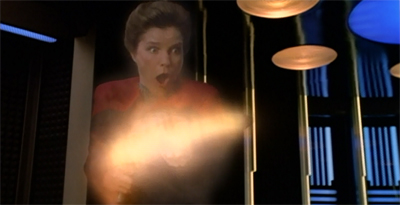
Talk about a hot ending.
As Zoë Sofoulis argues in Smart Spaces @ The Final Frontier, the episode makes great use of the holodeck as a metaphor for storytelling:
The meta-televisuality of the holodeck was brought out particularly acutely in an episode titled Worst Case Scenario near the end of Star Trek: Voyager’s third season, where the crew get involved in playing, then rescripting, an unfinished holonovel of a mutiny on Voyager featuring all the regular crew and secretly written by the security officer Tuvok as a training exercise. In support of the crew’s involvement in this diversion Captain janeway makes a speech about the importance of entertainment, culture and the arts, which resonates directly with the viewer’s own experience of watching Star Trek as entertainment. Various versions of the mutiny scenario are played out, and characters comment and criticise the way their scripts have been written, much as real actors would do with actual Star Trek scripts. Then the scenario turns dangerous once Tuvok gets in to finish the story, because the maquis saboteur Seska has completed the scenario in a way that puts the safety protocols off-line and threatens to kill Tuvok and Paris who is assisting him. “Who says deus ex machina is outmoded?” Janeway remarks, as she frantically scrambles to rewrite Seska’s narrative and script helpful events and tools into the story to save the two members of the crew.
In fact, at one point in the episode, Janeway and Torres are shown to be watching the drama play out on a small monitor that resembles a television screen.

How will Tom and Tuvok get out of this one?
Of course, the holodeck is not a perfect metaphor for television storytelling. In some ways, it seems better suited as a metaphor for more emersive narratives like video games. Indeed, there are several moments in Worst Case Scenario that seem to allude to the stylistic sensibilities of video games. There is a branching structure to the narrative, as evidenced by the differences in the story experienced by Paris and Torres. There are heavily-scripted dialogue and plot exposition scenes between the action. There is instructional text directing the player to the armoury to stock up.
Worst Case Scenario consciously alludes to these ideas. The characters talk about resetting the narrative to play out alternate scenarios. “I’ve decided to take B’Elanna’s advice and replay the holonovel, this time as a full-fledged member of Chakotay’s team of mutineers,” Paris reflects. “I hope it turns out better than before.” In the messhall, Neelix offers, “Chakotay caught me, phasered me, and the programme reset. Next time, I’m going to pretend to go along with the conspirators and then stage a counterstrike.”

All fired up.
The episode is structured to be repetitive, as Torres and Paris play through the same basic premise in different ways. There is the suggestion of loops and narrative choke-points, as if there are certain hardcoded storybeats that cannot be prevented by the player. There is even a fleeting suggestion of the amorality of this emersive storytelling. After all, Worst Case Scenario plays through a mutiny scenario – a scenario that runs largely counter to the franchise’s utopian philosophy.
In discussing their approach to the game, Paris and Torres debate the relative merits of siding with the mutineers. In what could possibly be read as a character-based decisions, Torres hesitates before siding with Chakotay while Paris makes a big show of being a rebel before aligning himself with Janeway. In fact, Tuvok even aligns the holographic version of Paris with Janeway, suggesting that the former jailbird is actually a boy scout in disguise. However, the crew also understand that these decisions are in theory value-neutral, having no consequences outside the game.
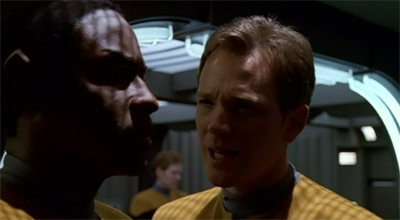
Paris is a little yellow this time around.
“You should have tried going along with the mutiny from the beginning,” Torres urges Tom. “It’s much more fun.” It should be noted that Worst Case Scenario was released in the mid-nineties, around the time that violence in video games was coming to public attention. The Entertainment Software Rating Board had been formed by the industry in 1994 as an attempt to pre-emptively block external regulation. The video game Phantasmagoria had generated no shortage of controversy on its release in 1995. Mortal Kombat was a lightning rod of controversy.
Things were about to get even more heated. Following the school shootings at Columbine and Heath High Schools later in the decade, the morality of video games would become a heated and controversial subject. Jack Thompson would file lawsuits trying to hold video game companies responsible for the actions committed by teenagers who had played their products. The release of the Grand Theft Auto video game series would open up a new front in the culture war. As such, the dispassionate approach that Voyager adopts to these moral choices is quite compelling.

Press “Ctrl + F” for Grand Theft Starship.
It is important not to overstate how eager Worst Case Scenario is to embrace (or even explore) the amoral world of video gaming. This is not Westworld, after all. There seems to be an unspoken assumption that the only “proper” ending to the adventure has Janeway retaking the ship; Tuvok’s first draft ends with her return while Paris’ first thought is to have Janeway assume command and brutally punish her opponents. Still, the script’s willingness to accept that the moral choices in a video game are part of the fun feels progressive in the context of the nineties.
Still, while there are elements of Worst Case Scenario that play as broad commentary on the nature of video games, the episode feels very much like an exploration of the writing style on Voyager. In some respects, the episode is at once a critique and a defence of the way that the production team have approached the show in its first three seasons. Indeed, the entire basis of the holonovel is an exploration of the squandered promise of Voyager‘s basic premise, the tension that existed between the Starfleet and Maquis crew.
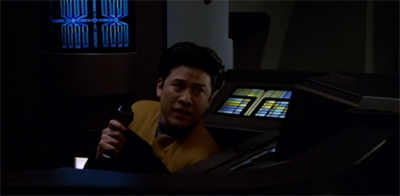
Little Kim.
In fact, Tuvok claims to have been inspired by the possibility of this sort of tension on the ship. “When you first invited the Maquis to join our crew, I believed that mutiny was a very real possibility,” Tuvok explains to Janeway. “With that in mind, I began to write a training programme for junior security officers to prepare them for such an eventuality.” Indeed, there were a number of early first season episodes that dealt with that tension; Parallax and Prime Factors both flirted with the possibility.
However, Voyager very quickly integrated its two crews and smoothed down the rough edges. Tuvok did not even get time to finish his story. “As the two crews began to work together, I concluded that the threat of an insurrection was increasingly unlikely,” he acknowledges. Given that Tuvok last accessed the file before Seska sabotaged it about a month before her departure in State of Flux, it seems likely that Tuvok reached that conclusion less than half-way through the first season. That feels about right.
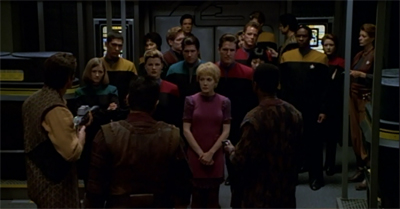
Holding the crew to Ransom.
holo!Chakotay criticises the direction of Voyager. He promises, “You’ll be part of a crew that’s going to do whatever it takes to get us home as fast as possible. Under my command, we won’t let almighty Federation principles get in the way of opportunities the way Janeway did when she destroyed the array that could have gotten us home. And we won’t be wasting precious time stopping to investigate every insignificant anomaly that we come across. What we will do is use any means necessary to acquire technology that can shorten our journey.”
These are all very valid charges against the creative decisions made early in Voyager‘s run. holo!Chakotay points out that there was never any debate about compromise or pragmatism when it comes to the ship’s situation. holo!Chakotay even draws attention to the series’ over-reliance on the stock “anomaly of the week” shows and the lack of emphasis on the basic premise of the series. Voyager is a show that never feels like it actually explored its core premise or its raw potential. holo!Chakotay takes the creators to task for this.
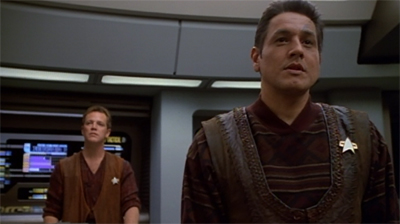
Chakotay is A-Okay!
Robert Beltran would be proud. The irony is that the rebellious and assertive version of Chakotay presented in Worst Case Scenario is much more compelling than the stock character who spurs exposition every other week. Beltran does not have the same raw charisma and charm that Jonathan Frakes used to stretch Riker beyond his two-dimensional origins, but he can play the cheeky and feckless rogue presented in Worst Case Scenario. The episode demonstrates that Chakotay’s biggest problem lies with the character’s direction more than the actor.
Indeed, Worst Case Scenario even seems to tease out the tense relationship that existed between the writers and the cast on the show. When Tuvok and Paris agree to write the ending to the holonovel, they find themselves beset by suggestions from their crewmates. Neelix is particularly self-centred. “He would never betray the Captain the way he does in that story,” Neelix insists. “No offence, Mister Vulcan, but I don’t think you understand my character very well.” Later, he proposes a new story “about a daring trader who becomes a cook on a starship.”
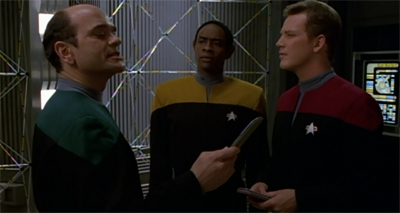
Author, Author.
This obviously reflects the awkward dialogue that would unfold between the creative staff and the performers working on the series. Robert Beltran has not pulled any punches in condemning the writers for various decisions they have made. Garrett Wang has been similarly blunt in his assessment of his relationship with the powers that be. Even Kate Mulgrew had a very strong and visceral reaction to the decision to add Seven of Nine to the cast at the start of the fourth season. There is a sense that the dynamic on Voyager could be quite tense.
However, as much as Worst Case Scenario is a criticism of Voyager or an exploration of various tensions, it is ultimately also a vindication for the writers’ approach to the show. Ultimately, Paris is proven correct. Logic and internal consistency are revealed to be secondary to the demands of the plot. Lazy writing is justified by necessity. In fact, Janeway is forced to re-write the programme coming down to a literal deadline, perhaps capturing the experience (and the inelegance) of writing for television.

Bringing Voyager low.
In some ways, Worst Case Scenario feels almost like a celebration of fan fiction. It is an episode in which the lead characters seem excited at being coopted and reimagined through the lens of what Torres describes as a “what if”, or what comic book fans might call an “elseworld”, or what genre fans would consider an “alternate universe.” Far from being outraged that some stranger has written a story using their likenesses and character traits, the senior staff seem to endorse the possibility.
“I’m more than just a Captain,” Janeway states in defence of holonovel. “I’m the leader of a community, and communities need entertainment, culture, creative outlets. Since we’re not exactly privy to every new piece of music or holonovel that’s written back home, I think it’s only natural that we should start creating our own.” It reads almost as a defence of the way that certain writer appropriate characters in the public domain or through fan fiction, using them to give voices to perspectives or communities often overlooked; like female or LGBT fans.

“Okay. You can write it Tom. But no slash.”
It should also be noted that the use of the holonovel within Worst Case Scenario solidifies a trend within Voyager. Much like Distant Origin, there is a sense that Worst Case Scenario hints at a motif that will soon become recurring. In Distant Origin, it was the idea of the story told from a perspective outside of the primary characters. In Worst Case Scenario, it is the concept of a story featuring copies or duplicates or doppelgangers of the original cast. Indeed, these two types of stories would occasionally overlap, as in Living Witness or Course: Oblivion.
The holonovel in Worst Case Scenario features holographic counterparts of the primary cast, copies of our regular characters that arguably play a much larger role in the story than any of the “flesh and blood” lead characters except for Tom Paris himself. Over its seven year run, Voyager becomes increasingly fixated with copies and replicas and interpretations of the lead characters. It frequently seems like the universe is populated with imitations and photocopies of the crew, to the point that it is hard to know what the “real” crew actually is.

The hard cell.
Deadlock was very much ground zero for that narrative trend. That second season episode featured two versions of the eponymous ship staffed by two identical crews, culminating in two versions of Janeway going head-to-head. However, the Voyager crew would spawn historical replicas in Living Witness, a cloned ship in Demon, con artist impersonators in Live Fast and Prosper, theatrical tributes in Muse, and holonovel characters in Author, Author. This is without getting into time-displaced copies, like the future!Janeway in Endgame.
While Deep Space Nine would visit the mirror universe roughly once a year, the show’s sense of time and reality never seemed quite as fragile as that on Voyager. In many ways, Voyager was a show rooted in the nineties zeitgeist, and part of that seemed to be a recurring anxiety about the nature of its existence. Voyager suggested that reality was a malleable construct, prone to distortion or manipulation in episodes as diverse as Projections, Year of Hell, Part I, Year of Hell, Part II and Latent Image.

Tuvok and roll.
Film and television were fixated upon this idea of a mediated and distorted reality. The Matrix is very much the poster child for this nineties fascination, but Randy Laist puts it in a broader cultural context:
Even though each of these cyberpunk narratives establishes its own mythology of how reality is structured, taken as a whole, the proliferation of these films suggests an increasing cultural inquiry into the phenomenological issues associated with a new kind of mediated reality. Another cinematic trend within which we can position The Matrix is that of ironic meta-movies, movies that self-consciously incorporate their status as pop-cultural products into their own thematic and narrative structure, such as The Brady Bunch Movie and its sequel, A Very Brady Sequel, Scream and its sequels, the Pierce Brosnan instalments of the James Bond franchise — GoldenEye, Tomorrow Never Dies, The World Is Not Enough, Die Another Day — and South Park: Bigger, Longer, and Uncut. The defining feature of this subgenre is that the films’ characters inhabit a reality that has the ontological status of a television show or film. These films reflect a situation similar to that depicted in Pleasantville and The Truman Show, in which human reality has become “televisualised”, depleted of the existential and humanist values associated with the classical understanding of reality and reorganised according to the values of mass-media culture. Encompassing both the cyberpunk films and the meta-movies is a wider cultural-cinematic trend of films that engage in one way or another with the Baudrillardian theme of the implosion of reality and representation. Seminal films of “the long 1990s”, such as JFK, Terminator 2: Judgment Day, True Lies , The Player, Jurassic Park, Natural Born Killers, Forrest Gump, Pulp Fiction, Face/Off, Fight Club, and Being John Malkovich, all engage with the problems and possibilities associated with the new style of reality that emerges following the collapse of the Cold War and the advent of simulacral technologies such as cloning, virtual reality and digitisation. Considered from within the context of these prevailing trends, The Matrix clearly holds a privileged place in the canon of 1990s hyperreality cinema.
Episodes like Distant Origin suggest that Voyager is fascinated with the idea of storytelling. Worst Case Scenario takes that idea one step further and suggests Voyager is fascinated with the idea of its own storytelling.

“I have some very strong feelings about Janeway’s direction as a character.”
In fact, it is worth comparing Worst Case Scenario to Our Man Bashir. Both are holodeck episodes that consciously play with the idea of storytelling. Indeed, Worst Case Scenario even borrows several cues from Our Man Bashir. It casts the ensemble in supporting roles as holodeck characters. It even has characters interrupt one another during their private time on the holodeck. “Are you in the habit of just walking in on people’s private holodeck time?” Torres demands. Paris responds, “We had a lunch date, remember?” Very Bashir, and very Garak.
However, both holodeck episodes speak to the perspective of the individual shows. Our Man Bashir is very much an episode about subverting the genre clichés and the expectations of this sort of story, much like Deep Space Nine was willing to subvert the expectations of a Star Trek series. In contrast, Worst Case Scenario is a collection of energetic plot developments thrown together with little regard for logic and with a fair convenient “deus ex machina”, much like the average episode of Voyager.

Deus without end.
To be fair, Worst Case Scenario has a lot going for it even beyond these cheeky postmodern reflections. In an interview with Cinefantastique, Kenneth Biller acknowledged that the episode was a lot of fun to write:
I won’t say it’s an out-and-out comedy. It ultimately has some serious jeopardy to a couple of the characters, but it’s a comic musing on the creative process. It operates on a lot of different levels. It’s a little inside stuff about the creation of the show, the process of writing for Star Trek, and the interaction between the actors who we write for, and the writing staff. It was a lot of fun to write.
That sense of fun and adventure shines through in Worst Case Scenario, particularly when contrasted with something as soul-numbingly dull as Displaced. It seems like a forty-five minute episode that was fun to air.
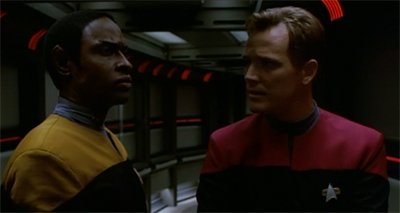
The write stuff.
There is a playfulness to the teleplay. Most notably, the episode waits until the end of the first act to confirm that it is actually a holonovel, although most astute observers will have figured it out by that point. Much like the decision to keep the first act of Distant Origin away from the title starship, Worst Case Scenario‘s willingness to wait so long before hitting the words “computer, freeze programme” speaks to an endearing confidence. Voyager spends far too much time compromising for its audience with scripts like Macrocosm or Darkling. This confidence is reassuring.
In fact, the first act of Worst Case Scenario is genuinely brilliant. Without providing clumsy exposition or voiceover, there is a slowly building sense of “wrongness.” There is a weird feeling of discontinuity to the dialogue and the action, based on what the audience knows of the crew at this point in the run. Why isn’t Torres wearing her rank insignia? How could this possibly be considered Chakotay’s first time in command? Why are Maquis tensions suddenly an issue now? Why is Seska there? Why did Seska refer to Torres as a “Starfleet” crewmember?

Hard to pin down.
Is this an alternate universe? Are the crew being affected by a strange interstellar phenomenon? For anybody paying any real attention “holodeck episode” quickly becomes the only possibility, and Worst Case Scenario confirms that theory at just the right moment. These little elements might seem frustrating if stretched over a single episode. However, it comes just late enough for the audience to feel smart for figuring it out, and just early enough that the plot can continue from that starting premise.
Even when the climax of the episode devolves into a silly little run-around, the script moves quickly enough that it is never boring. More than that, director Alexander Singer keeps the plot ticking over. Even when the holonovel’s introductory sequence plays on repeat for Paris, Singer finds a variety of new angles and tweaks the action just enough that it never becomes dull or lifeless. It is a credit to all involved that Worst Case Scenario flows so smoothly. Voyager has messed up the execution of much simpler story ideas in episodes like Rise.
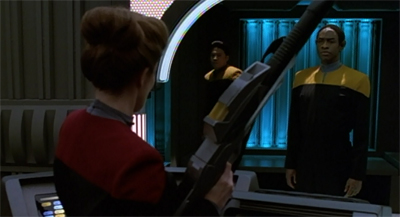
Breaking out of the box.
Worst Case Scenario suffers from a lack of sense or coherence, which is appropriate for an episode offering a commentary on the production of Voyager. At the same time, it is energetic enough (and fun enough) that it can get past these limitations, which feels like it captures the best possible interpretation of Voyager.
You might be interested in our other reviews from the third season of Star Trek: Voyager:
- Basics, Part II
- Flashback
- The Chute
- The Swarm
- False Profits
- Remember
- Sacred Ground
- Future’s End, Part I
- Future’s End, Part II
- Warlord
- The Q and the Grey
- Macrocosm
- Fair Trade
- Alter Ego
- Coda
- Blood Fever
- Unity
- Darkling
- Rise
- Favourite Son
- Before and After
- Real Life
- Distant Origin
- Displaced
- Worst Case Scenario
- Scorpion, Part I
Filed under: Voyager |




















Martha Hackett is great. I know the character was underwritten, but she milks every scene with her great facial expressions. See her crocodile grin when she says the holodeck has “been sealed”.
I never laugh watching the show, largely because the characters are as funny as a tumor. But the mere thought of Neelix coming at you (with a flaming hot iron) makes me chuckle every time. Tom was amusing in this episodes, too. The holodeck episodes always see him at his best.
I don’t know. I kinda laughed at Tuvok murdering Neelix in Meld.
But then, that might just be me.
Martha Hacket was not too pleased with the way Seska was killed off at the start of the season, so she returns at the end of it in what seems like an attempt by the writers to redress the balance. I have to say that Worst Case Scenario is a much more satisfying swan song for Seska and it certainly was for Hacket. You can see how much fun she’s having as she gets to do her departure from the show all over again and this time gets it right (she also suits the new hairdo much better than her S1 do).
Although WCS is not really intended to be more than a bit of late season filler, it emerges as one of S3’s better episodes. Seska’s not a bland antagonist like the Nyrians (who must rank as one of Trek’s most anonymous villains) and Martha Hacket gleefully chews on the scenery as she gets to stage her own takeover of Voyager (how many times has that happened this year?), even if it’s just a holographic one. I liked all of the little S1 touches and changes in perspective to the program as it feels like a nostalgic throwback to Voyager’s early years before the sweeping changes of S4.
Seska’s trap buried within the narrative is really the equivalent of an Easter Egg (I kept expecting something else to happen if I stayed through the end credits), which we’ve seen in similar episodes like Ship in a Bottle, Civil Defense, Babel and Badda-Bing, Badda-Bang. And Tom and Tuvok’s adventures on the Holodeck are as fun as they’re shared adventure in Future’s End. Yeah, Worst Case Scenario may be just trying to clear away some of the clutter before season’s end, so it’s ironic its one of S3’s more wholly enjoyable episodes.
Yep. It’s not particularly brilliant, but it’s fun. And that sense of fun carries the episode surprisingly far.
As much as I tend to love Voyager at its goofiest, it proved to be too far of a stretch for me to accept the idea that most of the crew, much less their captain, would be anything but apprehensive with people on the ship living out a detailed fantasy where the Maquis and Starfleet crew members ended up in a shooting war with each other over a conflict that was only a few years old and still very fresh in most crew members’ minds.
Sure, the show abandoned the series-long conflict that might have grown out of its split-crew concept, and while that decision squandered one of the biggest points of interest available to it at the premiere, it’s possible to accept that, within the fictional world of the series, nearly everyone aboard circled the wagons real quick in mutual defense of the ship.
But… just a few short years later, still trapped decades of travel away from everyone and everything they knew, that the Maquis crew would want to be reminded that the ship’s security officer betrayed all of them, then planned their defeat as mutineers by running his officers through a violent and graphic simulation of the same? That’s… kind of insane. That they’d want to play out the simulation themselves or that the captain would agree to that, is COMPLETELY nuts. In any believable plot, it would generate animosity, resentment and distrust that simply could not be ignored or reversed without serious consequences to the friendships among the main characters, at least within that single episode.
Imagine if you found out the security guards at your job had secretly identified you as a potential threat to be put down with lethal force based on your past associations, and had started creating a simulation training themselves to do so that included your name and likeness! How comfortable would you be working at that job in the future? Would you trust those security guards to look out for YOUR safety any further than you could throw them? Assuming your boss wanted people to get along at work, do you think they’d encourage people to play that simulation for fun? Now imagine your workplace is a million miles from nowhere, everyone’s there by accident and no one has the option of going home…
This seems like an episode that mutated from a mediocre pitch to a downright sleep-deprived-punchy, off-the-rails end result. That it was filmed and shown on TV suggests those behind this particular episode not only had little idea how to manage the show they were running, they also either had an extremely poor grasp of how people work (see above) or (more likely) they were utterly uninterested in making the characters in any way believable and not yet able to strike the sitcom-like tone they needed to make THAT work.
That’s all very fair. However, I think that it’s a larger issue with Voyager rather than a problem with this individual episode. At the very least, Worst Case Scenario is true to what Voyager is. It’s far (faaaaaaar) from a perfect episode, particularly when the last act turns into generic nonsense. However, it’s also fun and interesting for a lot of its runtime, which is more than can be said for a lot of Voyager episodes.
I’ve been going back and watching Voyager, guided in part by your reviews here, and that seems an accurate assessment!
Ha! Glad to be a (hopefully worthy) companion piece!